A manufacturer has three machines I, II and III installed in his factory. Machines I and II are capable of being operated for at most 12 hours whereas machine III must be operated for at least 5 hours a day. She produces only two items M and N each on the three machines are given in the following table:
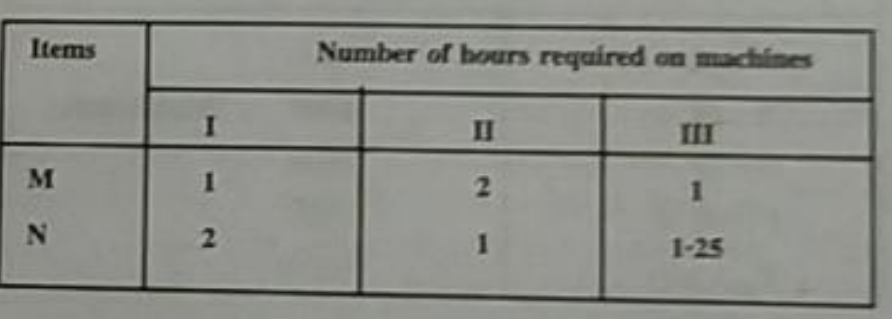 SHe makes a profit of Rs 600 and Rs 400 on items M and N respectively. How many of each item should she produce so as to maximise her profit assuming that she can sell all the items that she produced? What will be the maximum Profit?Solution in Punjabi
SHe makes a profit of Rs 600 and Rs 400 on items M and N respectively. How many of each item should she produce so as to maximise her profit assuming that she can sell all the items that she produced? What will be the maximum Profit?Solution in Punjabi
Step by step video & image solution for A manufacturer has three machines I, II and III installed in his factory. Machines I and II are capable of being operated for at most 12 hours whereas machine III must be operated for at least 5 hours a day. She produces only two items M and N each on the three machines are given in the following table: SHe makes a profit of Rs 600 and Rs 400 on items M and N respectively. How many of each item should she produce so as to maximise her profit assuming that she can sell all the items that she produced? What will be the maximum Profit? by Maths experts to help you in doubts & scoring excellent marks in Class 12 exams.
Updated on:21/07/2023Topper's Solved these Questions
- LINEAR PROGRAMMINGBOOK - PRADEEP PUBLICATIONCHAPTER - LINEAR PROGRAMMINGEXERCISE - EXERCISE
135 Videos
- INVERSE TRIGONOMETRIC FUNCTIONSBOOK - PRADEEP PUBLICATIONCHAPTER - INVERSE TRIGONOMETRIC FUNCTIONSEXERCISE - EXERCISE
279 Videos
- MATRICESBOOK - PRADEEP PUBLICATIONCHAPTER - MATRICESEXERCISE - EXERCISE
335 Videos
Similar Questions
Exhibit graphically the solution set of the following system of inequalities
x≥0,y≥0.
View SolutionFind the value of
sin−1(12)
View SolutionIF a matrix has 12 elements, what are the possible orders it has 7 elements?
View Solution(Manufacturing problem) A manufacturer has three machines I, II and III installed in his factory. Machines I and II are capable of being operated for at most 12 hours whereas machine HI must be operated for atleast 5 hours a day. She produces only two items M and N each requiring the use of all the three machines. The number of hours required for producing 1 unit of each of M and N on the three machines are given m the following table:She makes a profit of Rs 600 and Rs 400 on items M and N respectively. How many of each item should she produce so as to maximise her profit assuming that she can sell all the items that she produced? What will be the maximum profit?
View SolutionA manufacturer has three machines A,B and C installed in his factory. Machines A and B are capable of being operated for atmost 12 hours whereas machine C must be operated for atleast 5 hours a day. He produces only two items X and Y each requiring the use of all the three machines. The number of hours required for producing 1 unit of each of X and Y on three machines are given in the following table:
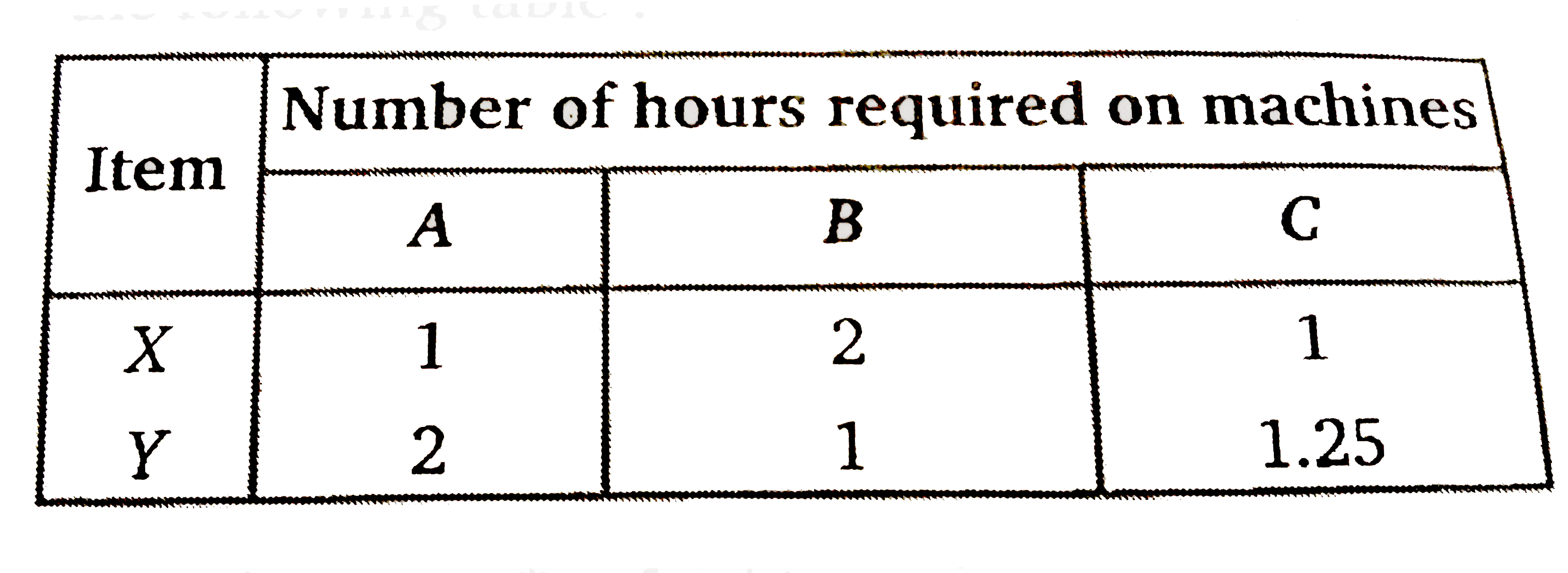
He makes a profit of Rs. 600 and Rs. 400 on each item of X and Y respectively. How many of each item should he produce so as to maximize his profit assuming that he can sell all the items that he produced?
View SolutionA manufacturer produces nuts and bolts. It takes 1 hour of work on machine A and 3 hours on machine B to produce a package of nuts. It takes 3 hours on machine A and 1 hour on machine B to produce a package of bolts. He earns a profit of Rs. 17.50 per package on nuts and Rs. 7.00 per package on bolts. How many packages of each should be produced each day so as to maximise his profit, if he operates his machines for at the most 12 hours a day?
View SolutionA manufacturer makes two models A and B of a product. Each model is processed by two machines. To complete one unit of model. A, machines I and II must work 1 hours and 3 hours respectively. To complete one unit of model B, machine I and II must work 2 hours and 1 hour respectively. Machine I may not operate for more than 8 hours per day, and machine II for not more than 9 hours per day. If profits on model A and B per unit are Rs. 300 and Rs. 350, then how many units of each model should be produced , per day, to maximize the profits ?
View Solutionउत्पादन संबंधी समस्या (Manufacturing problem ) एक उत्पादन के कारखाने में तीन I , II और III लगी हैं | मशीनें I और II अधिकतम 12 घंटे तक चलाए जाने की क्षमता रखती है । जबकि मशीन III प्रतिदिन कम से कम 5 घंटे चलना चाहिए । निर्माणकर्ता केवल दो प्रकार के सामान M और N का उत्पादन करता है, जिनमें प्रत्येक के उत्पादन में तीनों मशीनों की आवश्यकता होती है । M और N के प्रत्येक उत्पाद के एक नग उत्पादन में तीनों मशीनों के संगत लगे समय (घंटो में ) निम्न लिखित सारणी में दिए हैं ।
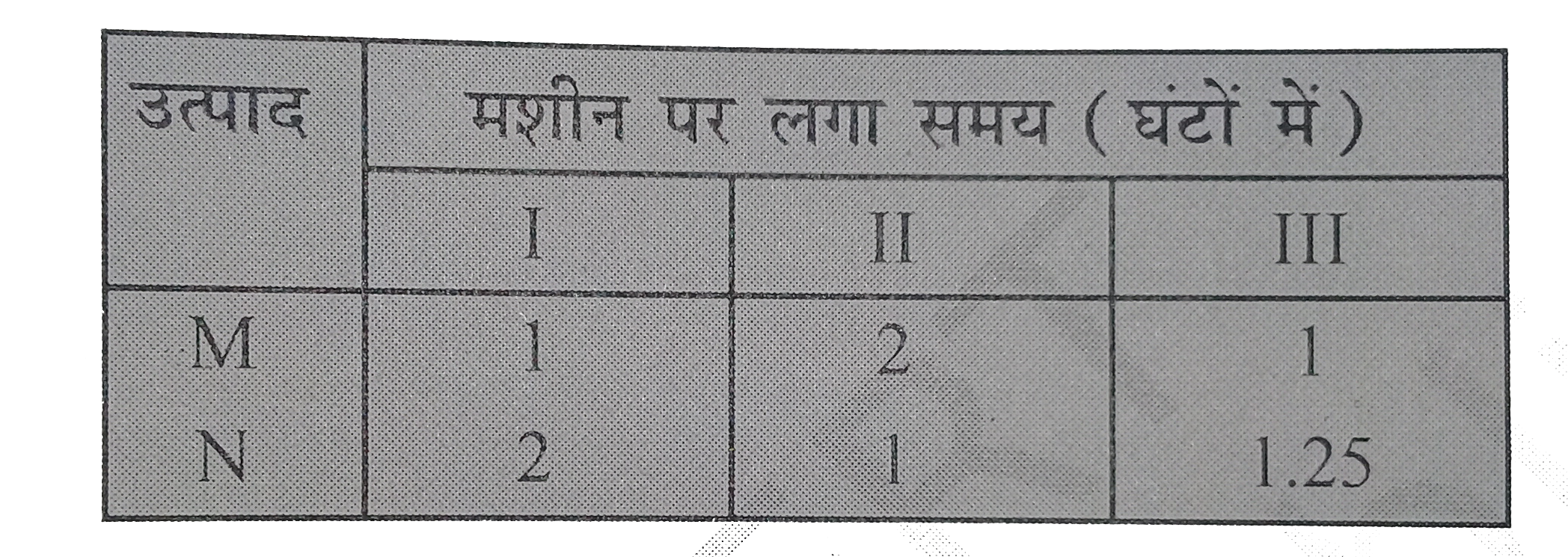
वह उत्पाद M पर Rs 600 प्रति नग और उत्पाद N पर Rs 400 प्रति नग की दर से लाभ कमाती है । मानते हुए कि उसके सभी उत्पाद बिक जाते हैं , जिनका उत्पादन किया गया है, तब ज्ञात कीजिए कि प्रत्येक उत्पाद के कितने नगों का उत्पादन किया जाए , जिससे लाभ का अधिकतमीकरण हो ? अधिकतम लाभ क्या होगा ?
View Solutionउत्पादन संबंधी समसया एक उत्पादन के कारखाने में तीन मशीनें I,II, III लगी हैं मशीनें I और II अधिकतम 12 घंटे तक चलाए जाने की क्षमता रखती है। जबकि मशीन III प्रतिदिन कम से कम 5 घंटे चलना चाहिनए। निर्माणकर्ता केवल दो प्रकार के सामान M और N का उत्पादन करता है जिनमें प्रत्येक के उत्पादन में तीनों मशीनों की आवश्यकता होती है। M और N के प्रत्येक उत्पाद के एक नग उत्पादन में तीनों मशीनों के संगत लगे समय (घंटों में) निम्नलिखित सारणी में दिए हैं।
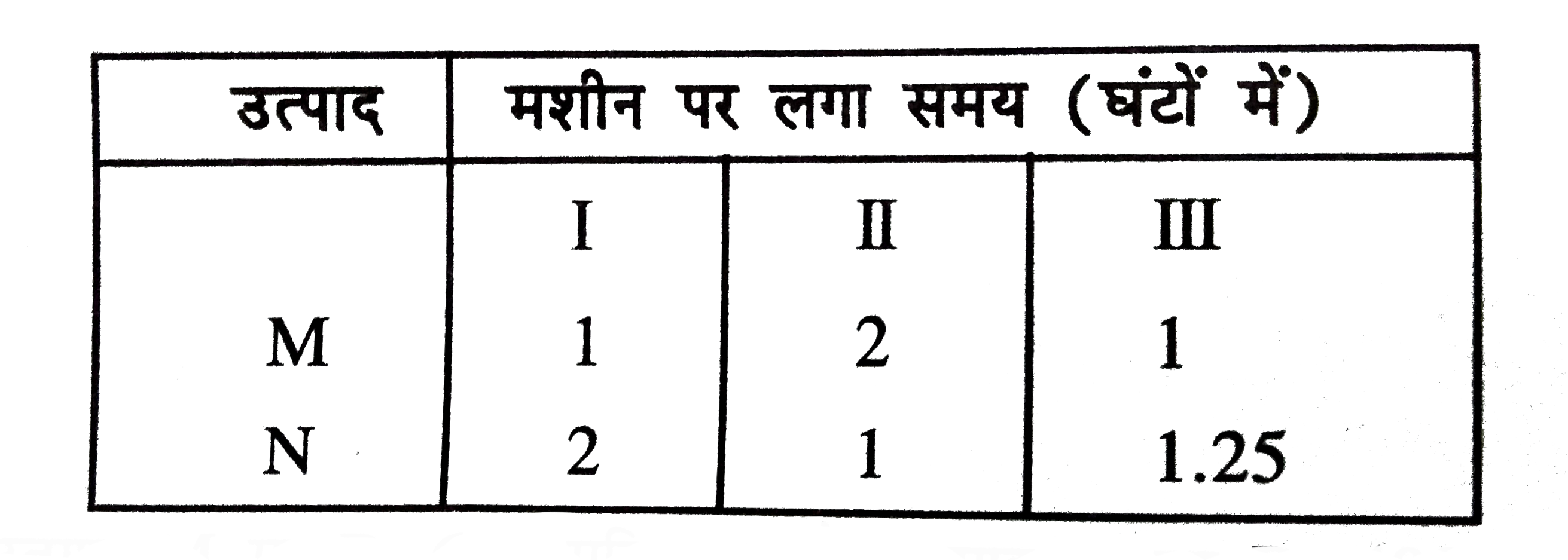
वह उत्पाद M पर Rs. 600 प्रति नग और उत्पाद N पर Rs. 400 प्रति नग की दर से लाभ कमाती है। मानते हुए कि उसके सभी उत्पाद बिक जाते हैं जिनका उत्पादन किया गया है तब ज्ञात कीजिए कि प्रत्येक उत्पाद के कितने नगों का उत्पादन किया जाए, जिससे लाभ का अधिकतमीकरण हो? अधिकतम लाभ क्या होगा?
View SolutionA factory has two Machines - I and II. Machine-I produced 60% if items and Machine - II produces 40% of the items of the total output. Further 2% of the items produced by Machine - I are defective whereas 4% produced by Machine - II are defective. If an item is drawn at random what is the probability that it is defective ?
View Solutionएक उत्पादन के कारखाने में तीन मशीनें I,II और III लगी हैं। मशीनें I और II अधिकतम 12 घण्टे तक चलाये जाने की क्षमता रखती हैं जबकि मशीन III प्रतिदिन कम-से-कम 5 घण्टे चलनी चाहिए। निर्माणकर्ता केवल दो प्रकार के सामान M और N का उत्पादन करता है ,जिनमें प्रत्येक के उत्पादन में तीनों मशीनों की आवश्यकता होती है। M और N के प्रत्येक उत्पाद के एक नग उत्पादन में तीनों मशीनों के संगत लगे समय (घण्टों में ) निम्नलिखित सारणी में दिए हैं -

वह उत्पाद M पर Rs 600 प्रति नग और उत्पाद N पर Rs 400 प्रति नग की दर से लाभ कमाती हैं। मानते हुए कि उसके सभी उत्पाद बिक जाते हैं, जिनका उत्पादन किया गया है, तब ज्ञात कीजिए कि प्रत्येक उत्पाद के कितने नगों का उत्पादन किया जाए, जिससे लाभ का अधिकतमीकरण हो ? अधिकतम लाभ क्या होगा ?
View SolutionA factory has two Machines - I and II. Machine - I produces 60% of items and Machine -II produces 40% of the items of the total output . Further 2% of the items produced by Machine-I are defective whereas 4% produced by Machine -II are defective . If an item is drawn at random what is the probability that it is defective ?
View SolutionA manufacturer has 3 machines I, II and III installed in his factory. Machines I and II are capable of being operated for utmost 12 hours whereas machine III must be operated atleast for 5 hours a day. He produces only two items A and B each requiring the use of three machines. The number of hours required for producing 1 unit of each of the items A and B on the three machines are given below.
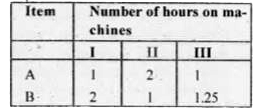
He makes a profit of Rs 7600 on item A and Rs 400 on item B. Assume that he can sell all that he produces.
(i) Formulate this as a linear programming problem.
(ii) Solve the L.P.P by corner point method.
View Solution(Manufacturing problem): A manufacturer has three machines. I, II and III installed in his factory. Machines I and II are capable of being operated for at most 12 hours whereas machine III must be operated for atleast 5 hours a day. She produces only two items M and N each requiring the sue of all the three machines.
The number of hours required for producing 1 unit of each of M and N on the three machies are given in the follownig table:

She makes a profit of Rs. 600 and Rs. 400 on items M and N respectively. How many of each item should be produce so as to maximise her profit assuming that she can sell all the items that she produced? What will be the maximum profit?
View Solution(Manufacturing problem): A manufacturer has three machines. I, II and III installed in his factory. Machines I and II are capable of being operated for at most 12 hours whereas machine III must be operated for atleast 5 hours a day. She produces only two items M and N each requiring the sue of all the three machines.
The number of hours required for producing 1 unit of each of M and N on the three machies are given in the follownig table:

She makes a profit of Rs. 600 and Rs. 400 on items M and N respectively. How many of each item should be produce so as to maximise her profit assuming that she can sell all the items that she produced? What will be the maximum profit?
View SolutionA manufacturer produces nuts and bolts. It takes 1 hour of work on machine A and 3 hours on machine B to produce a package of nuts. It takes 3 hours on machine A and 1 hour on machine B to produce a package of bolts. He earns a profit of Rs 17.50 per package on nuts and Rs 7.00 per package on bolts. How many packages of each should be produced each day so as to maximise his profit, if he operates his machine for at most 12 hours a day?
View Solution
